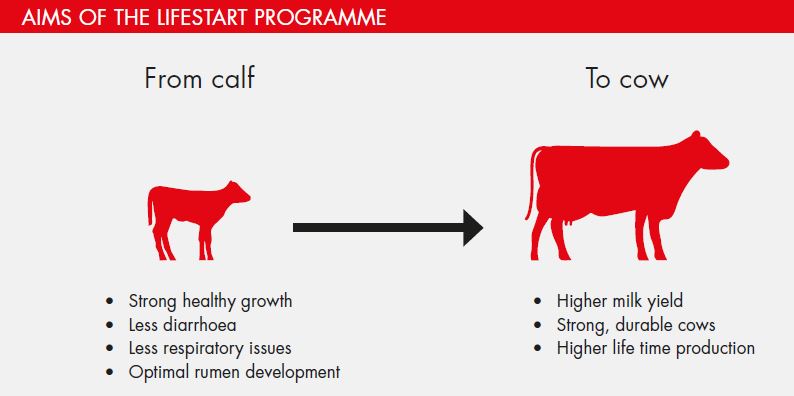For the dairy farmer, business success means balancing a wide range of factors. At the heart of this challenge lies the need to look after your cows and improve productivity, while controlling overall workload and costs.
Calf rearing is one of the most intensive and satisfying aspects of dairy farming and has always been considered important.
But, the true picture of just how crucial successful rearing is to the overall health and performance of a herd is now becoming clear.
Research has shown that high growth rates in the first weeks of life (800-1,000g/day) lead to increased milk production during the first and second lactation.
And, the first eight weeks of a calf’s life provide a huge opportunity to boost the lifetime performance of the cow.
This effect is defined as metabolic programming, whereby an animal’s productive potential as an adult is influenced by the growth achieved early in life.
Above average growth rates pre-weaning
The LifeStart programme, when used in conjunction with Milkivit milk replacers, derives from scientific studies that used intensive feeding to achieve above-average growth pre-weaning.
These studies conclusively prove that this increased rate of growth leads to greater productivity over the life-time of the cow.
LifeStart is dedicated to providing the information and expertise to help both farmers and the dairy industry take advantage of this exciting discovery.
Video: Calf growth rates and cow production explained
A step-by-step guide to following the LifeStart programme:
- After three days give the calf LifeStart approved high-quality milk replacer at a higher rate of 150g/L of water.
- From the second week provide good quality straw and calf concentrate or a specific calf dry TMR.
- Gradually increase the drinking volume to at least 6L/day during the first two weeks.
- Maintain the drinking volume of 6L/day until the sixth week of life.
- After six weeks begin to reduce the amount of milk by 1.5L on the first day, gradually reducing the volume to zero.
- In week nine, feed milk to the calves once a day (in the evening time).
- During cold weather increase the dosage of milk replacer by about 20%.
- Control diarrhoea using Farm-o-san Rediar.
- Give clean, fresh water all the time.
- Clean the drinking vessels immediately after every meal.
- Calves should have doubled their birth weight by eight weeks of age.
Milkivit – more than just a milk replacer
With the ever-present need to protect and nurture your animals and your business, it is common sense to want to give your calves the best possible start in life.
Milkivit provides you with a range of options to do just that.
The Milkivit range of milk replacers is made with the highest-quality skimmed milk and whey powders – providing the perfect balance of nutrients to rear strong, healthy calves.
Good for your calves; good for your business
For over 60 years, Milkivit has stood for the dedication to quality milk replacers and this experience, combined with the latest scientific knowledge, can help you ensure a healthy future for your dairy farm.
Milkivit milk replacers are made using the highest-quality ingredients, providing the best possible calf nutrition.
Formulated to meet different rearing and business objectives, (professional, premium and turbo meet the LifeStart quality criteria, defined through scientific studies.
The primary limiting amino acids for growth are lysine and methionine. Milkivit’s calf milk replacers are formulated to contain the optimum level of these essential amino acids.
The Milkivit calf milk replacer health pack also promotes the nutritional maintenance of a rapidly-growing calf, by supporting a healthy digestive and respiratory system.
For more information on the Milkivit range of milk replacers Click Here




